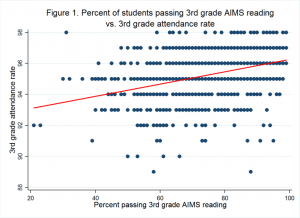Researchers from Arizona State University wanted to find out which factors might negatively impact a student’s ability to read by third grade. The answer for students in Arizona was clear: good attendance makes a real difference.
The research is associated with Read On Arizona, a statewide public and private partnership aimed at boosting language and literacy skills for children from birth through age eight. The team used data from a variety of sources and an average chronic absent rate of 10 percent for schools statewide. The study found that for a 1 percent increase in third grade attendance rates, there is an average increase of 1.5 percent of students passing the Arizona Instrument to Measure Standards (AIMS) third grade reading test at the school-level in 2013-2014.
On the other hand, for a 1 percent increase in chronic absenteeism (i.e. the percentage of students who miss 18 or more days in a given school year), there is an average decrease of 0.3 percent of students passing third grade AIMS reading, they found.
The researchers wrote about their analysis in a blog post for the Brookings Institution. While the data in this study are specific to Arizona, many of the challenges faced by Arizona are similar in states across the country. For example, in 2015, 38 percent of students in fourth grade fell below basic reading levels on the National Assessment of Educational Progress, placing the state only 6 percent below the national average, they wrote in the blog.
“Policymakers and practitioners are often faced with a variety of choices when it comes to ensuring that students reach their full academic potential,” the researchers wrote. “Although this seems intuitive, our analysis suggests that for those looking to improve student learning, particularly as it relates to literacy, increasing attendance rates may be critical first step.”
Find the full blog post here.